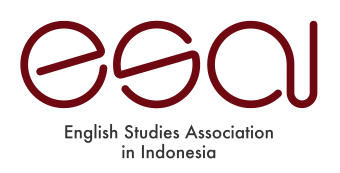EXPLORING THE EMERGING NON-STANDARD ENGLISH PRONUNCIATION FEATURES OF L1 JAVANESE AND INDONESIAN SPEAKERS
Abstract
Keywords
Full Text:
PDFReferences
Anderwald, L. (2017). World Englishes and dialectology. The Oxford handbook of world Englishes, 252.
Arsanto, A. Y., Prawinanto, A., & Bram, B. (2019). Interdental Consonant Sound Errors Made by First Semester Students of English Education of Sanata Dharma University. Vision: Journal for Language and Foreign Language Learning, 8(2), 118-132.
Bamgbose, A. (1998). Torn between the norms: Innovations in world Englishes. World englishes, 17(1).
Cohn, A. C., & Ravindranath, M. (2014). Local languages in Indonesia: Language maintenance or language shift. Linguistik Indonesia, 32(2), 131-148.
Crystal, D. (2003). English as a global language. Cambridge university press.
Deterding, D. (2013). Misunderstandings in English as a lingua franca: An analysis of ELF interactions in South-East Asia (Vol. 1). Walter de Gruyter.
Deterding, D., & Mohamad, N. R. (2016). The lingua franca core and Englishes in East and Southeast Asia. Asiatic: IIUM Journal of English Language and Literature, 10(2).
Dewi, R., Utami, P. T., & Hasanah, N. (2019). The Influence of L1 Phonological and Orthographic System in L2 Pronunciation: a Study of Brebes Javanese Learners of English. In Fifth Prasasti International Seminar on Linguistics (PRASASTI 2019) (pp. 221-229). Atlantis Press.
Durvasula, K., & Kahng, J. (2016). The role of phrasal phonology in speech perception: What perceptual epenthesis shows us. Journal of phonetics, 54, 15-34.
Jenkins, Jennifer. 2000. The Phonology of English as an International Language. Oxford: Oxford University Press.
Kartushina, N., & Frauenfelder, U. H. (2014). On the effects of L2 perception and of individual differences in L1 production on L2 pronunciation. Frontiers in psychology, 5, 105122.
Khansir, A. A., & Tajeri, M. (2015). The relationship between spelling and pronunciation in English language. Language in India, 15(12), 57-69.
Kusuma, Adhi. & Kurniati, Victa Sari Dwi. (2020). A Comparative Study of English and Javanese Sound Inventories. Tamansiswa International Journal in Education and Science (TIJES), Vol 2 (No. 1), Page 31-35.
Martin, K. I. (2017). The impact of L1 writing system on ESL knowledge of vowel and consonant spellings. Reading and Writing, 30, 279-298.
Ortín, R. (2023). ENGL6360 Descriptive Linguistics for Teachers.
Sidupa, C. (2018). Indonesian Language Transfer of Students of English as a Second Language (ESL). KnE Social Sciences, 51-57.
Van Rooy, B., Mukherjee, J., & Hundt, M. (2011). A principled distinction between error and conventionalized innovation in African Englishes. Exploring second-language varieties of English and learner Englishes, 44, 189-207.
Vančová, H. (2019). Current issues in pronunciation teaching to non-native learners of English. Journal of Language and Cultural Education, 7(2), 140-155.
Vaughn, C., Baese-Berk, M., & Idemaru, K. (2019). Re-examining phonetic variability in native and non-native speech. Phonetica, 76(5), 327-358.
Widagsa, R. (2017). Closing Diphthongs among Javanese Learners of English. Journal of Foreign Language Teaching and Learning, 2(2), 1-10.
DOI: http://dx.doi.org/10.30813/jelc.v15i1.5602
Refbacks
- There are currently no refbacks.



2.jpg)



